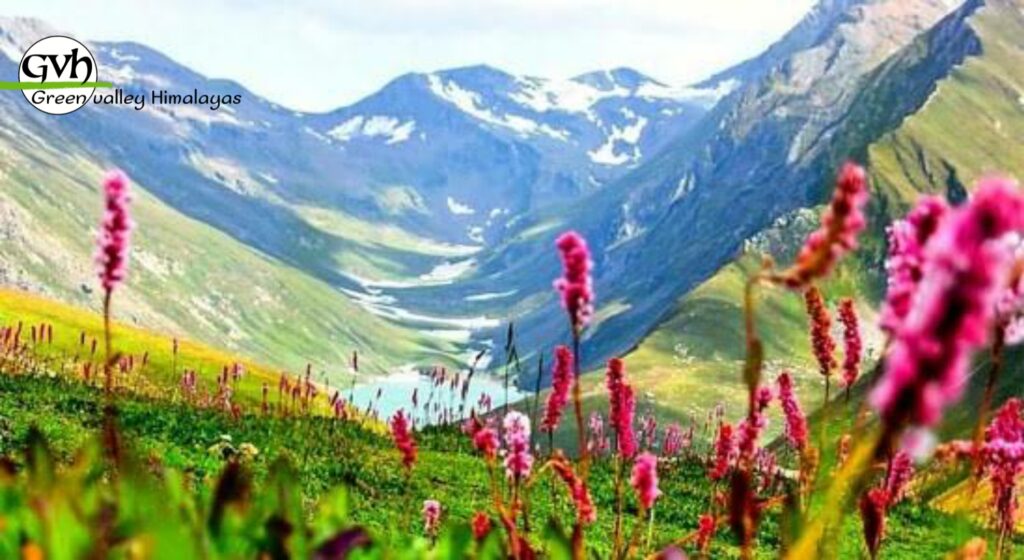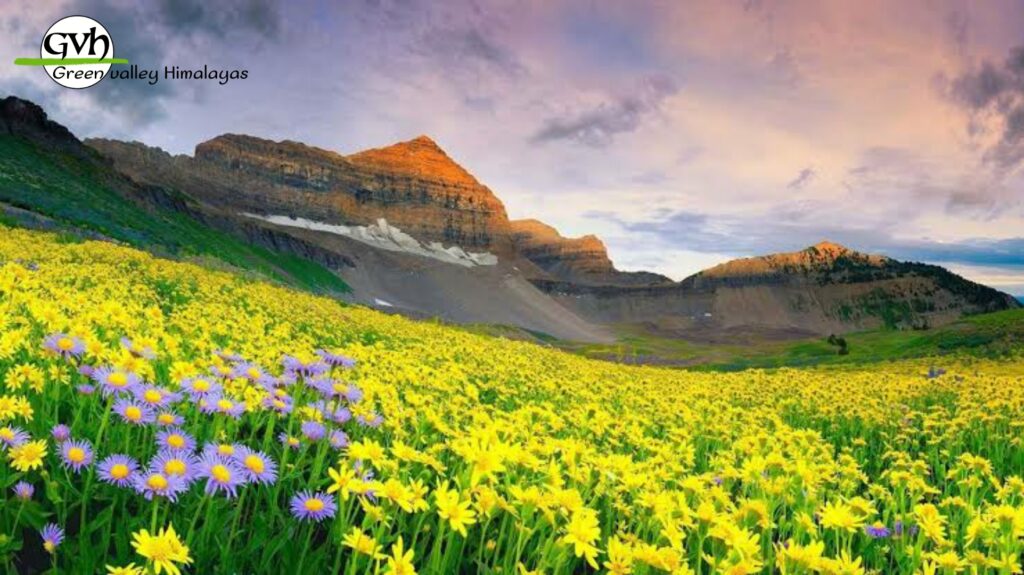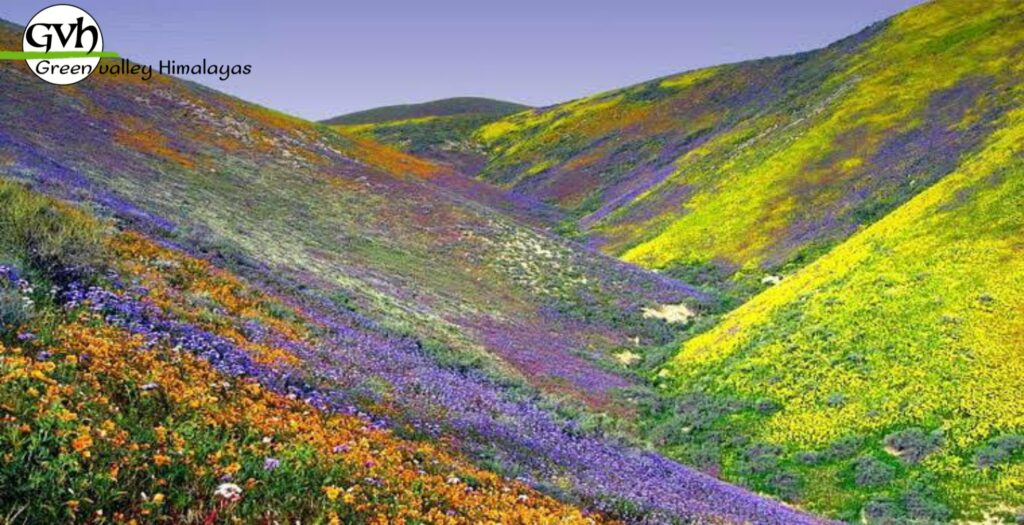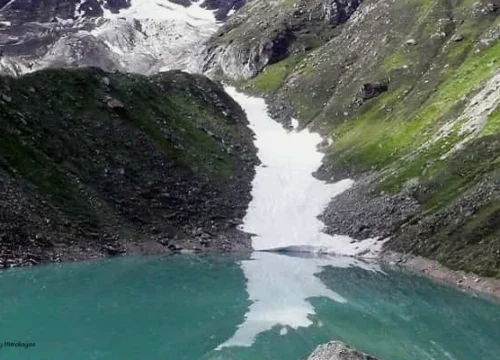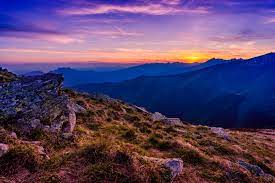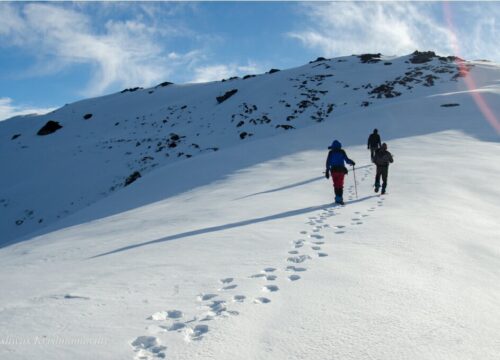Upcoming Valley of Flowers trek in Jul & Aug 2025: Every Sunday starting from Haridwar (6 Days). Submit the query form to get details in email.
Any admirer of Himalaya, thinking about a trek in Monsoon, Valley of Flowers trek will probably be a chart topper. Legend and myths met reality when three British mountaineers Frank Smythe, Eric Shipton and Romilly Holdsworth lost their way and reached this piece of paradise on earth. They were been to Mt. Kamet expedition (First ascent) and entered in to Bhyundar valley during their dramatic descent. They reached by descending through Bhyundar Khal (Pass) instead of as planned to reach Mana village. Hence the outer world knew that the valley exists. For locals the valley served as a pastoral grazing opportunity. According to Hindu mythology this is the Nandan Kanan, garden of Lord Indra. Valley of Flowers is a high altitude valley carved by glacial action of the river Pushpawati and runs east west direction along the river. According to a legend, the river was named Pushpawati by the Pandavas when they saw flowers floating on the waters of this snow fed river. This river meets Laxman Ganga coming from the Holy Shrine of Hemkund Sahib and called as Laxman Ganga or Bhyundar Ganga and meets Alaknanda at Govindghat. A gigantic snow clad ridge hems this valley from almost all sides. The valley is around 10Km long and 1 Km wide and situated ~ 3200 m – 3600 m from the mean sea level. The area blooms in alpine vegetation for a period of 15-20 weeks (June to October). The valley turns in pink, white, blue and violet cover during monsoon (July-August). Anemone, Balsam, Angelica, Bell Flower, Brahma Kamal, Blue Poppy, Forget Me Not, Cobra Lily, Marsh Marigold and Birch are few common types abundant inside the valley. Rataban peak and Tipra glacier mark the boundary of the valley in the upstream direction. This National Park is truly a botanist’s dream, an ornithologist’s charm, a photographer’s excitement and a hiker’s delight.
TREK FEE: ₹ 10500 (Govindghat to Govindghat) + 5% GST
Cost Includes
- Book for 5 persons or more and get 10% Group Discount on TREK FEE
- Inclusions:
- 2 nights accommodation at Govindghat (Day 1 & Day 5) in hotel/lodge on sharing basis (trip/quad). Male and female members will be housed in separate room (s).
- 3 nights stay at Ghangaria (Day 2, 3 & 4) in hotel/lodge on sharing basis (triple/quad). Male and female members will be housed in separate room (s).
- All Meals ( vegetarian) starting from Day 1 dinner to Day 5 dinner, including breakfast, hot/packed lunch, dinner with tea/soup.
- Excellent professional trekking guide, who will be a local to this particular area and has profound knowledge of the trekking trails around.
- Porters/Packed animals to carry the central logistics of the trek.
- Permit fee for Valley Of Flowers National Park.
- Basic Medical & First Aid kit.
- Travel and medical insurance for a duration of 7 days including high altitude trekking (For Indian citizens up to an age of 60 years).
Cost Excludes
- Transportation from Haridwar to Govindghat and back. ₹ 7000 for a Tata Sumo and ₹ 10000 for a Tempo Traveller one way. (₹ 2000 – 2500 per persons including pick up and drop when share by trekkers, payable directly to driver)
- We assume that you will carry your Rucksack/Backpack including all your personal belongings. If you prefer to offload your bag and carried by horse then an additional Rucksack offloading charge (₹ 800 for Govindghat to Ghangaria and back) is to be paid. One such bag must weigh within 10 Kg.
- Any tip/gratuity to the GVH supports staff.
- Anything is is NOT mentioned in the “Inclusions” or personal in nature.
-
7D/6N
-
12500ft
-
Easy
-
5.5/10
-
40 km
Valley Of Flowers Trek:
Upcoming Valley of Flowers trek in Jul & Aug 2025: Every Sunday starting from Haridwar (6 Days). Submit the query form to get details in email.
Any admirer of Himalaya, thinking about a trek in Monsoon, Valley of Flowers trek will probably be a chart topper. Legend and myths met reality when three British mountaineers Frank Smythe, Eric Shipton and Romilly Holdsworth lost their way and reached this piece of paradise on earth. They were been to Mt. Kamet expedition (First ascent) and entered in to Bhyundar valley during their dramatic descent. They reached by descending through Bhyundar Khal (Pass) instead of as planned to reach Mana village. Hence the outer world knew that the valley exists. For locals the valley served as a pastoral grazing opportunity. According to Hindu mythology this is the Nandan Kanan, garden of Lord Indra. Valley of Flowers is a high altitude valley carved by glacial action of the river Pushpawati and runs east west direction along the river. According to a legend, the river was named Pushpawati by the Pandavas when they saw flowers floating on the waters of this snow fed river. This river meets Laxman Ganga coming from the Holy Shrine of Hemkund Sahib and called as Laxman Ganga or Bhyundar Ganga and meets Alaknanda at Govindghat. A gigantic snow clad ridge hems this valley from almost all sides. The valley is around 10Km long and 1 Km wide and situated ~ 3200 m – 3600 m from the mean sea level. The area blooms in alpine vegetation for a period of 15-20 weeks (June to October). The valley turns in pink, white, blue and violet cover during monsoon (July-August). Anemone, Balsam, Angelica, Bell Flower, Brahma Kamal, Blue Poppy, Forget Me Not, Cobra Lily, Marsh Marigold and Birch are few common types abundant inside the valley. Rataban peak and Tipra glacier mark the boundary of the valley in the upstream direction. This National Park is truly a botanist’s dream, an ornithologist’s charm, a photographer’s excitement and a hiker’s delight.

The initial trail from Govindghat to Ghangaria is a long walk of 15 Km, though its mostly gradual along with Pushpawati River. Now a motor able road is constructed till Pulna village, and you may hire a car and share with the fellow trekkers. This reduces the trail around 4 Km and the initial climb from the bridge on the Alaknanda River. Second and the last climb is from Bhyunder village to the Helipad ground from where Ghangaria is another Kilometre walk. You will get tea-stalls/small dhaba throughout the trail within short intervals.
Though the paved walk till Ghangaria is not much of worth, but the things change completely inside Valley of flowers. The trail is pristine, no horse is allowed inside. This very special valley is indeed very charming for the experienced Himalayan hikers as well. We will walk to the head of the valley and return to Ghangaria.
Next we will visit Hemkund Sahib, a moderate climb to a large high altitude lake and the holy shrine. You may think of hiring a horse on the paved way, if you don’t wish to test your endurance. This track is different from the one inside valley, but does worth a visit. As you gain altitude you will get some snow section even as late as July. As we approach ~ 4000 m/13000 ft, the terrain gets rocks and ideal for Brahmakamal bloom.
Brief Itinerary:
Day 1: Drive from Haridwar to Govindghat – 290 Km – 12 hours
Day 2: Trek to Ghangaria – 14 Km – 7/8 hours
Day 3: Trek to Valley of Flowers and back to Ghangaria – 8 Km – 6/7 hours
Day 4: Trek to Hemkund Sahib and back to Ghangaria – 12 Km – 7/8 hours
Day 5: Trek to Govindghat – 14 Km – 6/7 hours
Day 6: Drive from Govindghat to Haridwar – 290 Km – 11/12 hours
Important note:
- You need to reach on your own to Haridwar on Day 1 morning (by 6 am) or the previous night. Return to Haridwar on Day 6 evening (by 9 pm). Arrange your tickets for inward journey and return from Haridwar accordingly. Transportation cost to reach Govindghat and return are included in the TREK FEE.
- Last ATM is at Joshimath, 20 Km before Govindghat. Withdraw cash well in advance either in Haridwar, Srinagar or Karnaprayag.
- Only BSNL network may work at trek base Govindghat, if you are lucky. Make a phone call back to home from Joshimath instead while reaching Govindghat.
Valley of Flowers trek distance and altitude profile:
Now the track is motorable from Govindghat to Pulna, 4 Km on the way to Ghangaria. This reduced the distance around 8 Km than it was few years back. Pulna to Ghangaria, to and fro is around 20 Km. Take 8 Km, to and fro to Valley Of Flowers from Ghangaria and another 12 for a return trek from Hemkund. You need to walk around total 40 Km or so on mostly paved track and trail inside the valley.
Below figure will give you an idea of the Valley Of Flowers trek distance and corresponding altitude profile.
Valley Of Flowers trek difficulty level: Is it suitable for first timers?
Yes, certainly this is a Himalayan trek which you can think to start with. We categorise it as an “Easy” grade trek. The trail is relatively longer than the usual Easy grade treks but there is no steep climb involved. The trail is paved or well marked. The climb to Hemkund Sahib can be tiring and slow ascend is recommended. Being a “Tea-House” trek you will stay in lodge throughout the trek and and may be convenient for the beginners. However you should keep in mind that this is a trekking trail, where you need to walk 6/7 hours a day and need basic physical fitness to complete the Valley Of Flowers trek comfortably. If you are not sure about carrying your own backpack, you have the option to offload the bag and carried by horse. This will be arranged with additional charges, if required.
Do I need special clothing or shoes for Valley Of Flowers trek?
It is always better and recommended to get specific warm clothing and trekking shoes for any Himalayan treks. However you can reuse your existing warm clothing and good quality rubber soled sports shoe for Valley Of Flowers trek. You may have to use layers of clothing. Remember waterproof outer layer is a MUST for this trek.
Valley Of Flowers trek best time to visit?
The seasonal bloom in the national park area begins as early as June and some flowers remain as late as end of September. Though it spans over a period of 16 weeks or more but you will get more species variety and flowering as the monsoon sets in properly. Considering this it is best to go for Valley of Flowers trek between late July to late August, spanning just over a month.
Valley of Flowers trek tour packages and cost:
Our usual scheduled Fixed Departure Valley of Flowers treks are of Economy/Budget type. The accommodation at lodge/hotel in Govindghat and Ghangaria will be shared with fellow trekkers. Note that this is NOT on twin sharing basis, but triple/quad. All meals will be simple vegetarian and nutritious. There will be one or more local expert trekking guide(s) depending on the strength of the group. He will be carrying basic medical kit as required and we stock oxygen cylinders at the lodges. You are protected with accidental insurance coverage aiming evacuation and hospitalisation which covers full itinerary. The TREK FEE is ₹ 8800 + 5% GST, Govindghat to Govindghat. Group discounts are as per policy for 3/5 or more persons on Fixed Departures. We may arrange your transportation from Haridwar to Govindghat and return on actual basis which is payable to the driver. Check the COST INCLUSIONS tab for detailed information.

We also arrange customised private tour packages to Valley Of Flowers. This is more flexible in nature as you can choose any date to start. TREK FEE depends on group size and type of accommodation. You can either opt for Economy/Budget type or avail the option of Standard/Premium type accommodation on twin sharing basis.
Expect a matching TREK FEE as of our Fixed Departure when you are a group of 6 to 8 persons. Inclusions will be same as the COST INCLUSIONS tab.
In premium twin sharing type we provide Hotel Bhagat at Govindghat and Luxury Swiss Tents at Ghangaria. This is mainly for families or small group of people, however we can arrange for larger group as well.
Valley of Flowers National park and it’s Biodiversity:
Cuddled on the high Himalayan peaks in Chamoli district of Garhwal, Valley of Flowers National Park is specially noted for its floral diversity and unmatched natural beauty. This biome is home for more than 500 species of vascular plants, 160 + species of birds and other insects and mammals.
The Nanda Devi National Park and Valley of Flowers National Park are exceptionally beautiful high-altitude West Himalayan landscapes with outstanding biodiversity. Both the parks form the core zones of the Nanda Devi Biosphere Reserve. (Source UNESCO: http://whc.unesco.org/en/list/335). The Park is declared as a UNESCO heritage site of biosphere reserve in 2005.
Flora inside Valley Of flowers:
This valley boosts more than 520 species (recorded and identified) of plant and flowers of which many are endemic to this area. To mention few: Himalayan Rose (Rosa Macrophylla); Himalayan Honeysuckle (Leycesteria formosa); Himalayan Blue Poppy (Meconopsis bella); Himalayan Mini Sunflower (Cremanthodium ellisii); Woolly Pearly Everlasting (Anaphalis Triplinervis); Brahma Kamal (Saussurea obvallata); Himalayan Cinquefoil (Potentilla Atrosanguinea) 8) Silky Woundwort (Stachys emodi) 9) Whiskered Commelina (Commelina benghalensis) 10) European Goldenrod (Solidago virgaurea) 11) Himalayan Thyme (Thymus linearis) 12) Woolly Pearly Everlasting (Anaphalis triplinervis) 13) Himalayan Rhodiola (Rhodiola himalensis) 14) Whorled Solomon’s Seal (Polygonatum verticillatum) 15) Devendra’s Balsam (Impatiens devendrae) 16) Purple Stalked Gentian (Gentiana pedicellata) 17) Showy Inula (Inula orientalis) 18) Jacquemont’s Cobra Lily (Arisaema jacquemontii) 19) Large Bellflower (Campanula latifolia) 20) Himalayan Milk Vetch (Astragalus himalayanus) 21) Himalayan Monkshood (Aconitum ferox) 22) Purple Stalked Gentian (Gentiana pedicellata) 23) Creeping Aster (Aster diplostephioides) 24) Himalayan Typhonium (Typhonium diversifolium) 25) Himalayan Thimbleweed (Anemone obtusiloba)

Fauna inside Valley Of Flowers:
This National Park together with Nanda Devi National Park forms one of the most bio diversified region on the Himalaya. This area is the home of many mammals including Asiatic black bear, Leopard, Snow leopard, Brown bear, Civet cat, Musk deer, Blue sheep, Serow and others. The bird type includes, Snowcock, Partridge, Monal, Pheasant, Vultures, Eagles, Laughing- thrushes, Warblers, Yuhina, Nuthatch, Honeyguide, Woodpeckers, Flycatchers, Magpies, Robins and Redstarts, Sunbirds, Accentors, Rosefinches etc. One can observe many species of colourful butterflies, moths and bees. Birding enthusiasts can check the list of available species in Valley of Flowers National Park from here.
References:
Concise Flowers of the Himalaya, illustrated edition by Adam Stainton & Oleg Polunin, ISBN: 9780195644142;
Pocket Guide to the Birds of the Indian Subontinent, Grimmett & Inskipp, ISBN: 9780195651553;
Birds of India, Om Field Guides by Krys Kazmierczak, ISBN: 9788187107040;
National parks of India by R.S.Bisht, ISBN: 8123001789;
EDC (Eco Development Committee), Bhyundar;
Access to Valley Of Flowers trek base – Govindghat:
To reach the trek base Govindghat you need to reach Haridwar on your own arrangements. Haridwar is well connected by train from Delhi and Kolkata. Frequent regular and Volvo bus service from Delhi Kashmiri Gate ISBT.
We will arrange a pickup from Haridwar railway station to Govindghat and back. This will be shared by the team members on actual basis and paid directly to the driver. You pay directly to the driver/owner. The fare is ₹ 6500 for a Tata Sumo/Mahindra Maxx one way. This can accommodate 5 to 6 people. A Tempo Traveller charges Rs 9500 (12-13 seat) one way. This is NOT included in TREK FEE.
To reach the trek base Govindghat independently or by public transportation, check the details in GETTING THERE TAB
Trip Highlights
- Duration: 4 days of trekking; Govindghat to valley of flowers and Hemkund Sahib and back to Govindghat. Haridwar to Haridwar in 6 days.
- Prerequisite: No prior trekking experience is required and ideal for beginners. Longish walk on the first day to Ghangaria (14 Km).
- Grade: Easy
- Physicality: 5.5/10
- Trail Length: 40 Km
- Highest Point: Hemkund Sahib~ 4160 m/13650 ft.
- Seasons: June to September (Best in July and August)
- Further Option: Trek to Bhyunder Khal (Difficult) or Kagbhusandi Tal (Moderate)
- Access: Trek starting point and end point is Govindghat which can is 290 Km from Haridwar.
- Rail station: Haridwar (STN Code: HW)
- Airport: Delhi; Dehradun (Airport Code: DED)

